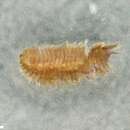Bhawania: Brief Summary
provided by wikipedia EN
Bhawania is a genus of polychaete worms in the family Chrysopetalidae.
- license
- cc-by-sa-3.0
- copyright
- Wikipedia authors and editors
Diagnosis
provided by World Register of Marine Species
(after Perkins, 1985). Chrysopetalinae with body broad, depressed and long (to 200 segments). Paleae fan yellow to golden bright, completely imbricate dorsally, exhibiting mid-dorsal line surface smooth. Prostomium rectangular, laterally fused with the anterior segments. Pharynx with a pair of thick stylet jaws. Segment 1 reduced, dorsal and ventral cirri present; segment 2 reduced and fused with segment 3, dorsal cirri present, ventral cirri absent; segment 3 reduced, dorsal and ventral cirri present. Posterior segments with dorsal and ventral cirri. Dorsal cirri with cirrophores shorts, cirrostyles retractile into cirrophores. Notochaetae symmetrical with internal ribs and horizontal striae; at the apex, the horizontal striae and internal ribs form a fragile reticulate surface. Main paleae with raised ribs with flattened denticles. Pygidium rounded with two anal cirri, with a medial anal cone. (additional comment by Cruz-Gómez, 2021) “ Traditionally, the genus Bhawania has been recognized as worms with numerous segments, with a small retracted prostomium and lack of nuchal organ [eg Fauchald 1977]. These features are still important; however, other features to be considered are: long body with depressed dorsum; dorsum completely covered by bright yellow paleae; paleae fan markedly imbricated over the mid-dorsal line, main paleae with raised ribs with flattened denticles, and all notochaetal groups with a delicate transparent reticular distal end.

